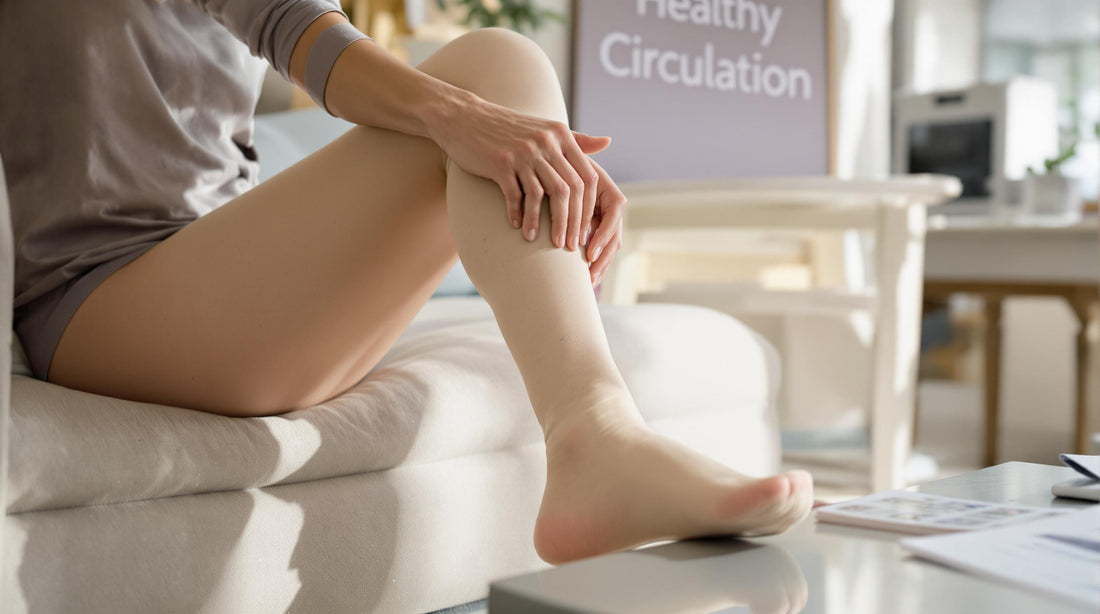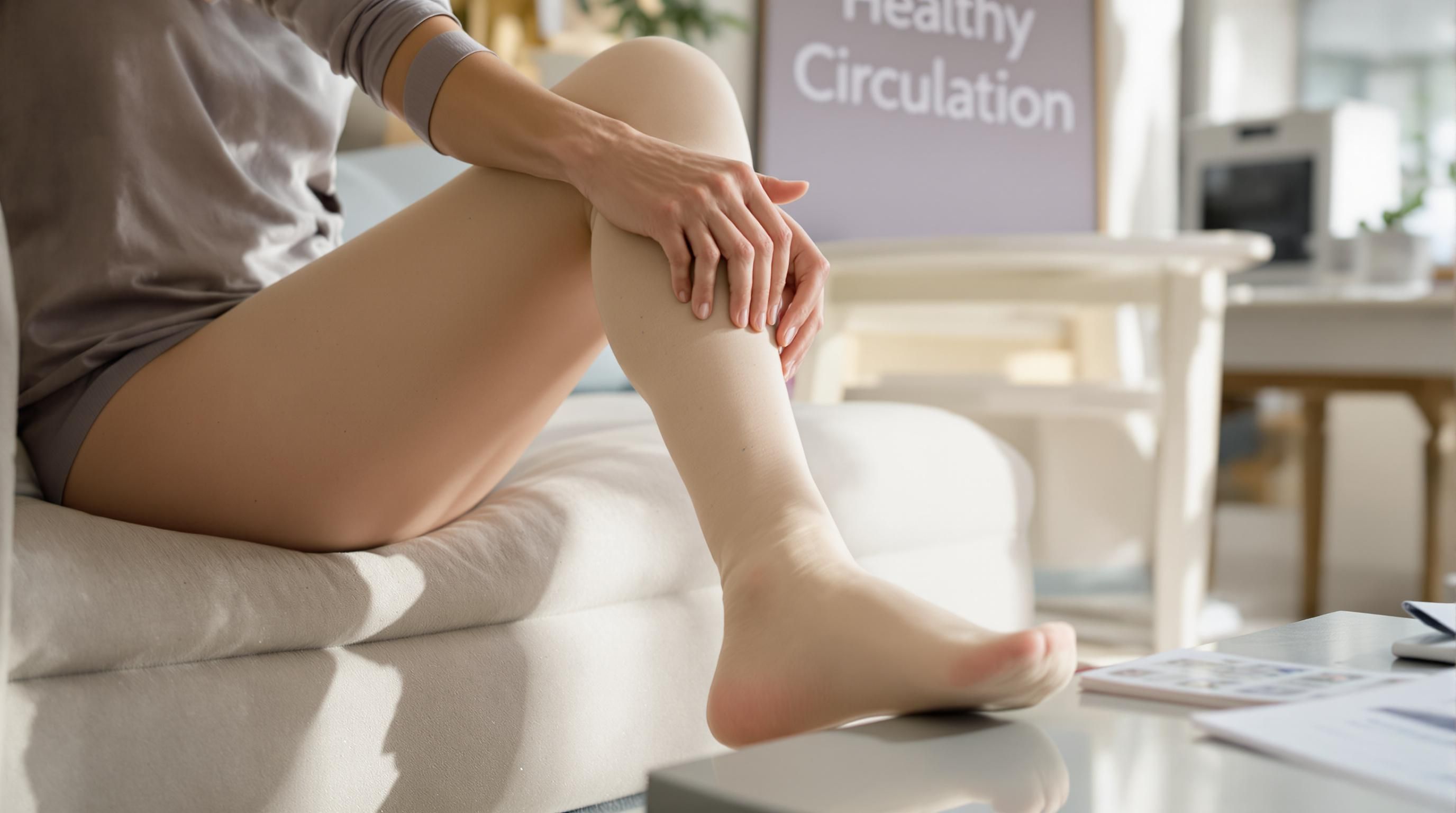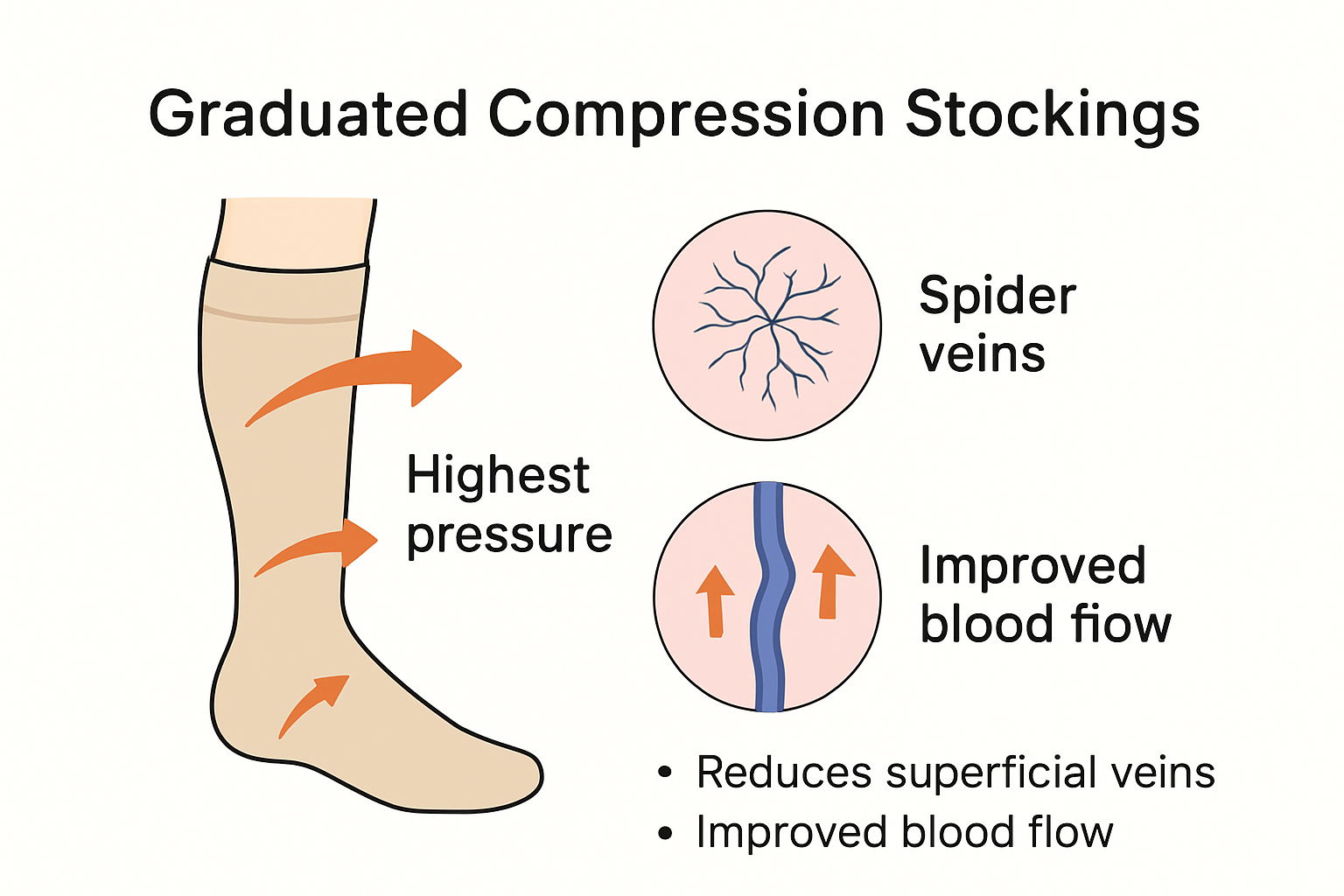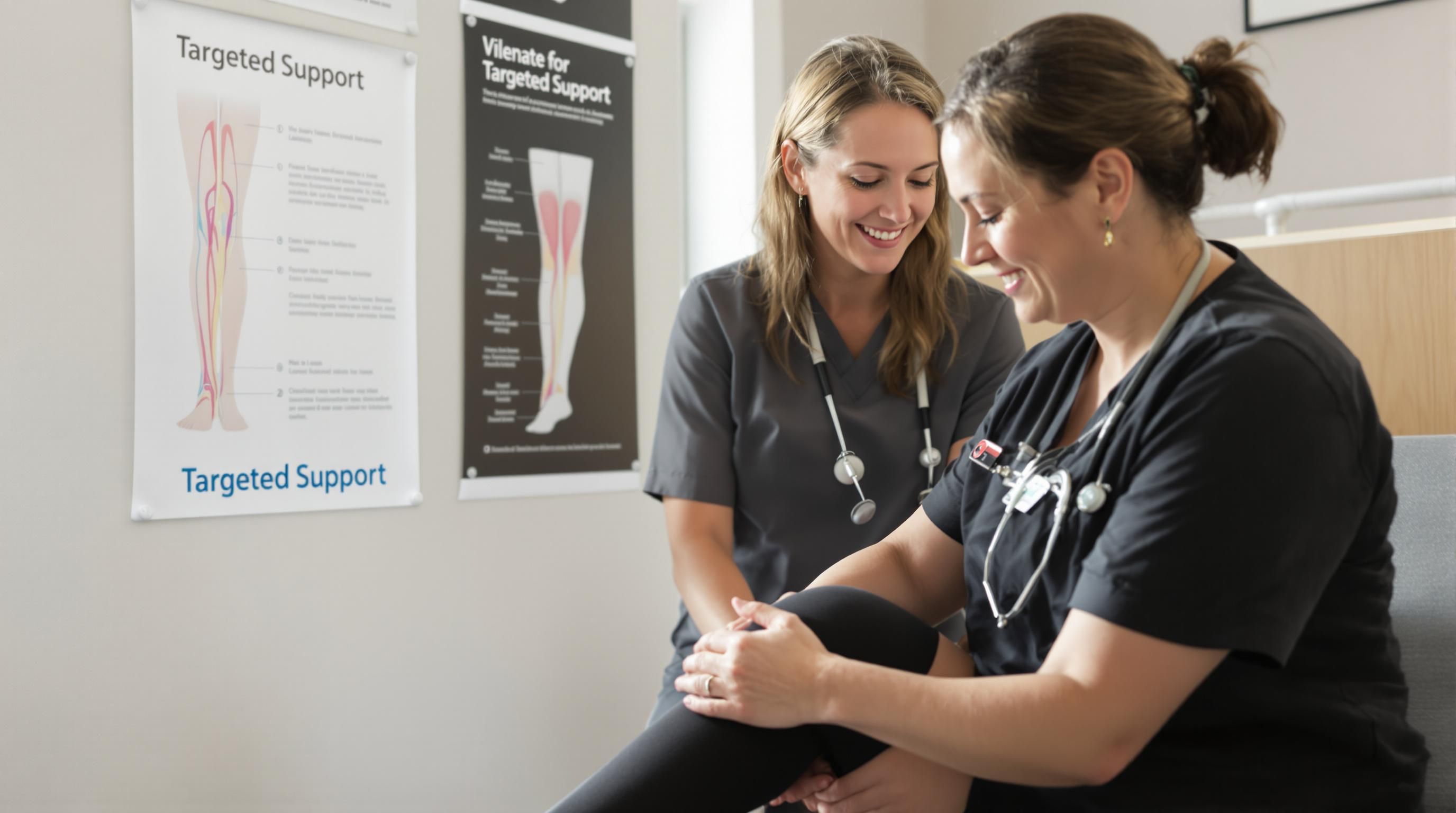
Can Compression Stockings Help Spider Veins? Benefit Guide 2025
Share

Spider veins can make your legs feel heavy and look uneven, sparking frustration for millions of people each year. Here is what surprises most folks. Wearing compression stockings can actually improve circulation and reduce the visibility of spider veins over time, with studies showing enhanced symptom relief in as little as three weeks. Most assume these garments are just for comfort or recovery, but their real power comes from the way they support your veins and protect your long-term vascular health.
Table of Contents
- How Compression Stockings Work On Spider Veins
- Who Should Consider Compression Stockings
- Health Benefits And Expected Results
- Tips For Choosing And Using Compression Stockings
Quick Summary
| Takeaway | Explanation |
|---|---|
| Compression stockings improve circulation. | They apply graduated pressure to support blood flow, reducing symptoms associated with spider veins. |
| Consult a healthcare professional for proper use. | Recommended levels of compression vary by individual conditions; professional advice ensures effective treatment. |
| Choose the right compression level. | Options range from mild to firm, with each level catering to specific circulatory needs and conditions. |
| Wear stockings consistently for best results. | Regular use leads to improved comfort and reduced visibility of spider veins over time. |
| Maintain stockings for optimal effectiveness. | Proper washing and checking for wear ensure the stockings provide the intended therapeutic benefits. |
How Compression Stockings Work on Spider Veins
Spider veins can be frustrating and unsightly, but compression stockings offer a strategic approach to managing these tiny visible blood vessels. Understanding how these specialized garments interact with your circulatory system reveals their potential effectiveness in addressing spider vein concerns.
The Mechanics of Compression Therapy
Compression stockings work through a precise mechanism of graduated pressure that actively supports blood circulation. Learn more about proper compression techniques to maximize their therapeutic potential. According to research from the National Institutes of Health, compression therapy applies strategic external pressure that helps compress superficial veins, pushing blood toward deeper venous systems and reducing venous pressure.

The key to compression stockings’ effectiveness lies in their graduated design. These garments are tightest at the ankle and gradually become less constrictive as they move up the leg. This intentional pressure gradient creates a pumping action that assists blood flow against gravity. By maintaining consistent pressure, compression stockings help prevent blood from pooling in lower extremities, which can contribute to the formation and visibility of spider veins.
Addressing Circulation and Vascular Health
Spider veins often develop due to weakened or damaged venous valves that struggle to return blood efficiently to the heart. According to Cleveland Clinic research, compression therapy helps increase blood circulation in the lower legs, ankles, and feet. This improved circulation can potentially minimize the appearance and progression of spider veins by reducing venous congestion and supporting overall vascular health.
The therapeutic benefits extend beyond mere cosmetic improvement. Compression stockings provide consistent external support that helps prevent blood from stagnating in peripheral vessels. By promoting more efficient blood return, these garments can alleviate symptoms associated with spider veins such as heaviness, aching, and mild swelling. While they may not completely eliminate existing spider veins, they offer a proactive approach to managing circulatory challenges and preventing further vascular complications.
Patients considering compression stockings for spider veins should consult healthcare professionals to determine the most appropriate compression level and fit. Not all spider veins respond identically to compression therapy, and individual medical histories play a crucial role in determining treatment effectiveness. Compression levels typically range from mild (15-20 mmHg) to moderate (20-30 mmHg), with each level offering different therapeutic benefits based on individual circulatory needs.
By understanding the intricate mechanics of how compression stockings interact with your circulatory system, you can make informed decisions about managing spider veins and supporting long-term vascular health. These specialized garments represent more than just a cosmetic solution - they are a strategic tool in maintaining lower extremity circulation and potentially mitigating the progression of venous conditions.
Who Should Consider Compression Stockings
Compression stockings are not a one-size-fits-all solution, but they offer significant benefits for various individuals experiencing specific health conditions and lifestyle challenges. Understanding who can most benefit from these specialized garments helps ensure targeted and effective support for circulatory health.
Medical Conditions Requiring Compression Support
Certain medical conditions make compression stockings particularly valuable. Discover the right compression level for your needs to address specific health concerns. According to Yale Medicine, individuals at high risk include patients with varicose veins, deep vein thrombosis, and those experiencing chronic leg swelling.
Patients with venous disorders benefit significantly from compression therapy. Research published in the National Library of Medicine indicates that graduated compression stockings are recommended for patients with symptomatic varicose veins, edema, skin changes, and active or healed venous ulcerations. These medical conditions create an ideal scenario for compression garment intervention, helping to improve symptoms and enhance overall quality of life.
Lifestyle and Occupational Considerations
Beyond medical conditions, certain lifestyle factors make compression stockings an excellent choice. Professionals who spend extended periods standing or sitting - such as nurses, teachers, retail workers, and office employees - can experience significant circulatory benefits. These individuals often develop leg fatigue, swelling, and discomfort due to prolonged static positioning, which compression stockings can effectively mitigate.
Athletes and fitness enthusiasts also find compression stockings advantageous. Runners, cyclists, and endurance athletes use these garments to support muscle recovery, reduce muscle vibration, and potentially decrease post-exercise soreness. The graduated pressure helps improve blood circulation, potentially enhancing performance and reducing recovery time.
Pregnant women represent another key demographic that can benefit from compression stockings. During pregnancy, hormonal changes and increased blood volume can lead to leg swelling and discomfort. Compression stockings provide gentle support, helping to reduce the risk of varicose veins and alleviating leg heaviness associated with pregnancy-related circulatory changes.

Travelers, particularly those undertaking long-distance flights or extended periods of immobility, can significantly reduce their risk of developing blood clots by wearing compression stockings. The garments help maintain blood flow during extended periods of sitting, which can be crucial for preventing potentially dangerous circulatory complications.
While compression stockings offer widespread benefits, it’s essential to consult healthcare professionals to determine the most appropriate compression level and style for individual needs. Factors such as existing medical conditions, severity of symptoms, and personal comfort should guide selection. Not everyone requires the same level of compression, and professional guidance ensures optimal therapeutic outcomes.
Compression stockings represent more than just a medical accessory - they are a proactive tool for maintaining circulatory health across diverse populations. By understanding who can benefit most from these garments, individuals can make informed decisions about supporting their vascular wellness and overall physical comfort.
To further clarify who may benefit from compression stockings, the following table summarizes key groups and their specific needs as described in the article:
| Who Benefits | Reason/Need |
|---|---|
| Patients with varicose veins or edema | Reduces symptoms and risk of progression |
| Those with chronic leg swelling | Improves comfort and circulation |
| Individuals at risk for deep vein thrombosis | Prevents clot formation and enhances blood flow |
| Pregnant women | Reduces swelling and risk of varicose veins |
| Professionals standing/sitting long hours | Alleviates leg fatigue, swelling, and discomfort |
| Athletes/active individuals | Supports recovery and reduces muscle soreness |
| Long-distance travelers | Helps lower risk of blood clots during prolonged immobility |
Health Benefits and Expected Results
Compression stockings offer more than just aesthetic improvements for individuals struggling with spider veins. They provide a comprehensive approach to managing circulatory health, delivering multiple therapeutic benefits that extend beyond surface-level vascular concerns.
Therapeutic Impact on Venous Function
Understand the science behind compression therapy with our comprehensive guide. According to research published in PubMed, graded compression elastic stockings help preserve lower leg venous caliber and tone throughout deep, superficial, and perforating venous systems during normal ambulatory activity. This preservation of venous structure is crucial in managing and potentially preventing the progression of spider veins.
The mechanical pressure applied by compression stockings creates a significant physiological response. By applying graduated pressure from the ankle upward, these garments actively support blood circulation, reducing venous stasis and minimizing the risk of blood pooling. This mechanism is particularly beneficial for individuals experiencing early signs of venous insufficiency or those prone to developing spider veins.
Clinical Outcomes and Treatment Enhancement
Compression stockings play a pivotal role in complementing medical treatments for spider veins. A randomized controlled study published in PubMed revealed that wearing compression stockings (23 to 32 mm Hg) for three weeks after sclerotherapy enhanced the clinical disappearance of leg telangiectasias. This finding underscores the potential of compression stockings as a supportive therapy in comprehensive vascular treatment protocols.
Patients can expect several key benefits from consistent compression stocking use:
- Reduced Swelling: Compression helps minimize leg and ankle edema by promoting efficient fluid drainage.
- Pain Relief: The consistent pressure can alleviate discomfort associated with spider veins and related circulatory issues.
- Improved Circulation: Enhanced blood flow reduces the risk of blood clots and supports overall vascular health.
The expected results vary depending on individual factors such as age, existing venous conditions, compression level, and consistent usage. While compression stockings cannot completely eliminate existing spider veins, they can significantly improve symptoms, prevent further progression, and support long-term vascular health.
Individuals should have realistic expectations about compression stocking outcomes. Most users report gradual improvements in leg comfort, reduced visible vein prominence, and decreased leg fatigue. However, the most substantial benefits are observed with consistent, long-term use and when combined with other lifestyle modifications such as regular exercise, maintaining a healthy weight, and avoiding prolonged standing or sitting.
Healthcare professionals recommend selecting the appropriate compression level based on individual needs. Mild compression (15-20 mmHg) works well for preventative measures and minor circulatory issues, while moderate to high compression levels (20-30 mmHg or 30-40 mmHg) are more suitable for individuals with more pronounced venous challenges.
Ultimately, compression stockings represent a proactive approach to managing spider veins and supporting overall leg health. By understanding their therapeutic potential and maintaining realistic expectations, individuals can effectively integrate these garments into their wellness strategy, potentially mitigating the progression of venous conditions and improving quality of life.
Tips for Choosing and Using Compression Stockings
Selecting and using compression stockings requires careful consideration to ensure maximum effectiveness and comfort for managing spider veins and supporting circulatory health. Understanding the nuanced process of choosing the right compression garment can significantly impact your therapeutic outcomes.
Selecting the Right Compression Level
Explore our comprehensive compression stocking guide to make an informed decision. According to Yale Medicine, determining the appropriate compression level is crucial for addressing individual medical needs. Compression stockings are typically categorized into different pressure ranges:
- Mild Compression (15-20 mmHg): Ideal for preventive care, mild swelling, and everyday use
- Moderate Compression (20-30 mmHg): Recommended for more significant circulatory issues and symptomatic spider veins
- Firm Compression (30-40 mmHg): Typically prescribed for severe venous conditions under medical supervision
Healthcare professionals strongly recommend consulting a medical expert to determine the most suitable compression level based on individual health conditions, symptoms, and overall circulatory health.
The following table compares the different compression stocking pressure levels discussed in the article to help you quickly identify which may be right for specific circumstances:
| Compression Level | Pressure Range | Best For |
|---|---|---|
| Mild | 15-20 mmHg | Preventive care, mild swelling, everyday use |
| Moderate | 20-30 mmHg | More significant circulatory issues, symptomatic veins |
| Firm | 30-40 mmHg | Severe venous conditions (under medical supervision) |
Proper Fitting and Application Techniques
Mastering the perfect compression stocking fit is essential for optimal therapeutic benefits. According to WebMD, proper application involves several critical steps:
- Measure legs accurately in the morning when swelling is minimal
- Ensure stockings are smooth and free of wrinkles when worn
- Put on stockings before significant daily activities or leg swelling occurs
- Smooth out any creases or folds to maintain consistent compression
- Replace stockings every 3-6 months to maintain optimal elasticity and effectiveness
Precise measurements are crucial. Improper sizing can lead to reduced effectiveness or potential discomfort. Most manufacturers provide detailed sizing charts that account for leg circumference, ankle width, and calf length.
Maintenance and Long-Term Care
Compression stockings require specific care to maintain their therapeutic properties. Wash them regularly in lukewarm water with mild soap, avoiding harsh detergents or fabric softeners that can degrade the elastic fibers. Air dry the stockings, keeping them away from direct heat sources like radiators or sunlight.
Users should inspect their compression stockings regularly for signs of wear, such as thinning fabric, loss of elasticity, or visible damage. These indicators suggest it’s time for replacement to ensure consistent therapeutic pressure and effectiveness.
While compression stockings offer significant benefits, they are not without potential challenges. Some individuals might experience initial discomfort, skin irritation, or difficulty putting them on. Patience and proper technique are key to adapting to these specialized garments.
Individuals with specific medical conditions like diabetes, severe peripheral neuropathy, or skin sensitivities should consult healthcare professionals before using compression stockings. Some skin conditions or open wounds might contraindicate their use or require specialized approaches.
By understanding and implementing these comprehensive tips, users can maximize the therapeutic potential of compression stockings in managing spider veins and supporting overall leg health. The right approach combines professional guidance, proper selection, precise fitting, and diligent maintenance.
Frequently Asked Questions
Can compression stockings improve the appearance of spider veins?
Wearing compression stockings can help improve circulation, which may reduce the visibility of spider veins over time, although they may not completely eliminate them.
Who should consider wearing compression stockings for spider veins?
Individuals with venous disorders, chronic leg swelling, pregnant women, and those who spend long hours standing or sitting may benefit from compression stockings for spider veins.
How long should I wear compression stockings to see results?
Many users report enhanced symptom relief in as little as three weeks with consistent wear, but results can vary based on individual conditions and adherence to wearing the stockings.
What compression level is best for managing spider veins?
Mild compression (15-20 mmHg) is often recommended for preventive care, while moderate compression (20-30 mmHg) may be more suitable for symptomatic spider veins. Consulting a healthcare professional is advisable for personalized recommendations.
Feel the Difference Real Compression Makes for Spider Veins
Are you tired of heavy, achy legs or worried your spider veins will only get worse? As explained in this guide, wearing the right graduated compression stockings can help boost circulation, ease discomfort, and reduce the visible signs of spider veins. But finding a trustworthy solution that fits your unique needs is not always easy. Many people struggle with choosing the correct compression level, the best style, or even knowing which brand to trust for reliable relief.
You deserve comfort and results that last. At Fit Stockings, we offer a curated selection of medical-grade options, including our top-rated Jobst collection and comfortable waist high pantyhose, all designed for effective spider vein support. If you are ready to take control of your leg health and finally feel confident about managing your spider veins, explore our store now. Free shipping, hassle-free returns, and expert guidance are waiting for you at Fit Stockings. See the benefits for yourself today and experience a real change.
Recommended
- Compression Stockings Fitting Guide 2025: Find the Perfect Fit – Fit Stockings
- Knee High Compression Stockings: Health Benefits and Guide 2025 – Fit Stockings
- Top Benefits of Compression Socks for Health in 2025 – Fit Stockings
- The Ultimate Guide to Compression Stockings: Comfort, Health, and Styl – Fit Stockings

